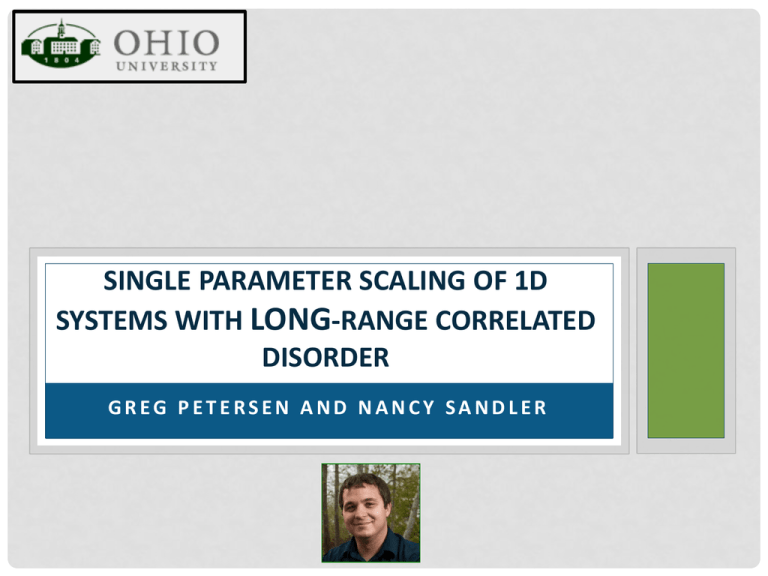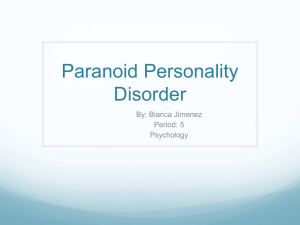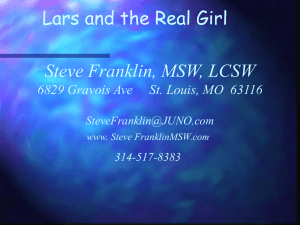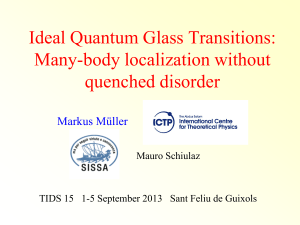Scaling and characterization of eigenstates in 1D power
advertisement

SINGLE PARAMETER SCALING OF 1D SYSTEMS WITH LONG-RANGE CORRELATED DISORDER GREG PETERSEN AND NANCY SANDLER WHY CORRELATED DISORDER? Long standing question: role of correlations in Anderson localization. Potentially accessible in meso and nanomaterials: disorder is or can be ‘correlated’. GRAPHENE: RIPPLED AND STRAINED http://www.materials.manchester.ac.uk/ E.E. Zumalt, Univ. of Texas at Austin Bao et al. Nature Nanotech. 2009 Lau et al. Mat. Today 2012 MULTIFERROICS: MAGNETIC TWEED Scaling exponent N. Mathur Cambridge http://www.msm.cam.ac.uk/dmg/Research/In dex.html Correlation length of disorder Theory: Porta et al PRB 2007 BEC IN OPTICAL LATTICES Billy et al. Nature 2008 http://www.lcf.institutoptique.fr/Groupes-derecherche/Optiqueatomique/Experiences/Transport-Quantique Theory: Sanchez-Palencia et al. PRL 2007. DISORDER CORRELATIONS Quasi-periodic real space order Random disorder amplitudes chosen from a This work: discrete set of scale values.free power law correlated potential (more in Greg’s Specific talk). long range correlations (spectral function) Some (not complete!) references: Johnston and Kramer Z. Phys. B 1986 Dunlap, Wu and Phillips, PRL 1990 De Moura and Lyra, PRL 1998 Jitomirskaya, Ann. Math 1999 Izrailev and Krokhin, PRL 1999 Dominguez-Adame et al, PRL 2003 Shima et al PRB 2004 Kaya, EPJ B 2007 Avila and Damanik, Invent. Math 2008 Reviews: Evers and Mirlin, Rev. Mod. Phys. 2008 Izrailev, Krokhin and Makarov, Phys. Reps. 2012 OUTLINE Scaling of conductance Localization length Participation Ratio G. Petersen and NS submitted. HOW DOES A POWER LAW LONG-RANGE DISORDER LOOK LIKE? () 1 V (r )V 0 µ a r Smoothening effect as correlations increase MODEL AND GENERATION OF POTENTIAL Tight binding Hamiltonian: Correlation function: Spectral function: Fast Fourier Transform (Discrete Fourier transform) CONDUCTANCE SCALING I: METHOD Conductance from transmission function T: Green’s function*: Self-energy: *Recursive Green’s Function method Hybridization: CONDUCTANCE SCALING II: BETA FUNCTION? NEGATIVE! COLLAPSE! IS THIS SINGLE PARAMETER SCALING? CONDUCTANCE SCALING III: SECOND MOMENT Single Parameter Scaling: Shapiro, Phil. Mag. 1987 ESPS Heinrichs, J.Phys.Cond Mat. 2004 (short range) CONDUCTANCE SCALING IV: ESPS WEAK DISORDER CORRELATIONS CONDUCTANCE SCALING V: RESCALING OF DISORDER STRENGTH Derrida and Gardner J. Phys. France 1984 Russ et al Phil. Mag. 1998 Russ, PRB 2002 LOCALIZATION LENGTH I Lyapunov exponent obtained from Transfer Matrix: EC w/t =1 Russ et al Physica A 1999 Croy et al EPL 2011 LOCALIZATION LENGTH II: EC Enhanced localization Enhanced localization length LOCALIZATION LENGTH III: CRITICAL EXPONENT w/t=1 PARTICIPATION RATIO I E/t = 0.1IS THERE ANY DIFFERENCE? E/t = 1.7 PARTICIPATION RATIO II: FRACTAL EXPONENT E/t = 0.1 E/t = 1.7 HOW DOES DISORDER AFFECT CRITICAL EXPONENTS? Classical systems: Harris criterion (‘73): “A 2d disordered system has a continuous phase transition (2nd order) with the same critical exponents as the pure system (no disorder) if n Consistency criterion: As the transition is approached, fluctuations should grow less than mean values. EXTENDED HARRIS CRITERION Weinrib and Halperin (PRB 1983): True if disorder has short-range correlations only. For a disorder potential with long-range correlations: There are two regimes: Long-range correlated disorder destabilizes the classical critical point! (=relevant perturbation => changes critical exponents) BRINGING ALL TOGETHER: CONCLUSIONS No Anderson transition !!!!! Scaling is ‘valid’ within a region determined by disorder strength that is renormalized by and D appear to follow the Extended Harris Criterion SUPPORT NSF- PIRE NSF- MWN - CIAM Ohio University Condensed Matter and Surface Science Graduate Fellowship Ohio University Nanoscale and Quantum Phenomena Institute










